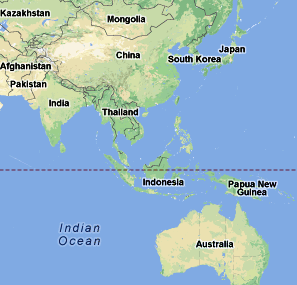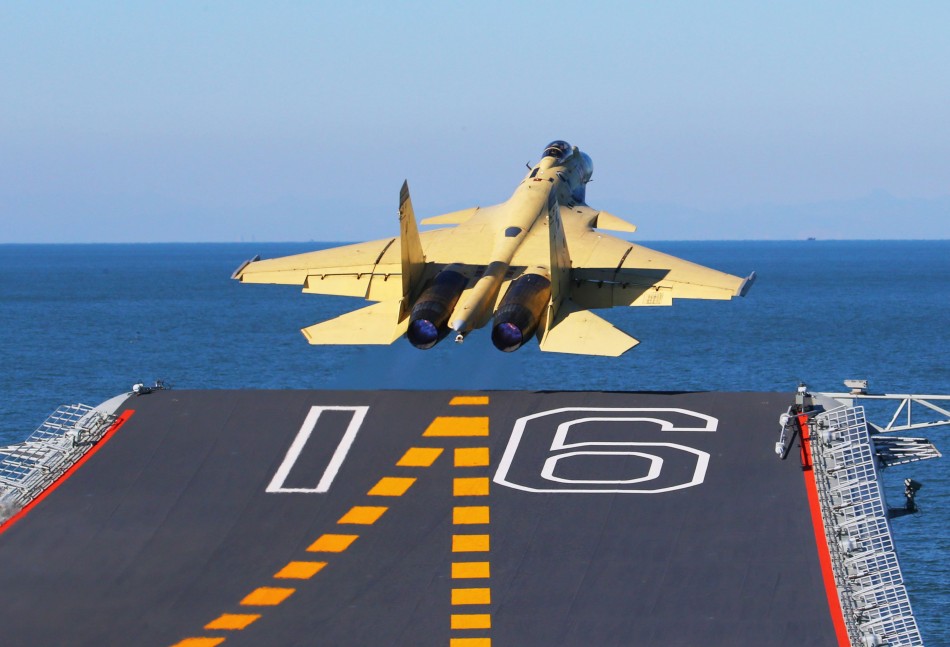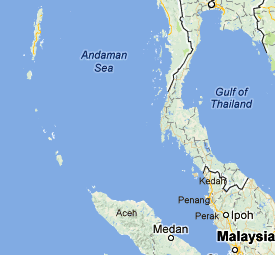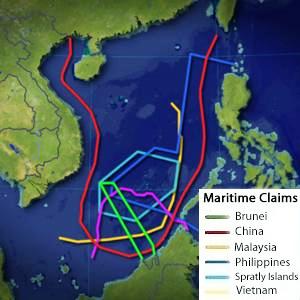By Felix Seidler, Institute for Security Policy, University of Kiel, Germany / German blogger.
Less Liaoning

Nothing has been as over-hyped since August 2011 as China’s aircraft carrier program. After the former Soviet carrier Varyag, fully refurbished by the Chinese and renamed Liaoning, took its first “test drive”, thousands of blog posts, press pieces, and scholarly articles argued about possible regional and global implications. Is this single ship a regional or even global threat? What about the balance in the East and South China Seas?
Stay calm, people. After a few tests, China’s Navy – the People’s Liberation Army Navy (PLAN) – has shown it is in fact still years away from having an operational aircraft carrier, let alone integrated carrier strike group.
Moreover, if a navy wants to have a single operationally available aircraft carrier at any one time, it needs at least two, and better still three carriers in rotation: the one in operational status, one in the shipyard, and one in training and work-ups. According to these numbers, it is unlikely that the PLAN will be able to sustain a “blue water” carrier presence before 2020 based on projected shipbuilding schedules.
Even the first flights of a J-15 Shark from Liaoning’s deck were more PR event than step towards a credible carrier force. It’s one thing to launch a single fighter under controlled and planned conditions. Conducting dozens of flight movements per hour in wartime requires a significant increase in capabilities and training. To reach this, China must still walk a long road.
Eye on India

However, while most observers were busy with Liaoning, Asia’s only operational aircraft carrier, India’s INS Viraat, has largely been left out of the discussion (sorry, Thailand, but your never-operating carrier is not a serious asset). The first reason why India’s carrier must be taken more seriously than China: operational experience. India has been operating its current carrier since 1987 (the now-decommissioned INS Vikrant began service in 1961), and already has in place the necessary supply chains and logistics that the PLAN lacks. China’s maritime “Long March” could take longer than Mao’s to gain all the experience India already has. And while both China and India could turn to Russia for potential assistance, only the latter would likely receive carrier support – whether logistics or training – from the U.S., France, or the U.K.
Unlike their Chinese counterparts, Indian commanders already conduct serious exercises with their helicopter and fighter pilots integrated with their carrier crews. China, due to the lack of capacity (i.e. a carrier at sea) has not yet started the most crucial parts of its carrier training. Russian experts warn it may take the Chinese another decade to learn how to “efficiently” run carrier operations. Meanwhile, India’s next carrier INS Vikramaditya (former Soviet Admiral Gorshkov), due the benefits of Russian support, is already training in Arctic waters and is expected despite delays to enter service in late 2013 or 2014. The indigenously built INS Vikrant is slated to be commissioned in 2015. In consequence, whenever the PLAN’s first carrier is operational, India will have at least two well-trained counterparts (Viraat is set to decommission in 2020). Furthermore, India will generally be able to maintain one operational carrier off-shore while China, at least initially, will not.
New Delhi and The Three Carrier Big Boys
Beside Russian support – generous, but not free – India participates in joint exercises with the navies of the other two “Carrier Big Boys,” the U.S. and France. The PLAN is far from such trials and, beyond search and rescue (SAR), these navies by policy will not conduct full-scale combat training with a Chinese carrier, their possible future foe.
For instance, in April 2012, the U.S. and India conducted the 15th joint naval Exercise Malabar; which also included warships from Australia, Japan, and Singapore. Training with the U.S. means that India has the opportunity to look at and, thereby, learn from the skills of the world’s best carrier-operating navy. However, Indians pilots have not yet been reported taking off from U.S. carriers. Also unprecedented but not improbable, India’s carrier officers, pilots, and crews could hone their skills training side-by-side with the world’s best counterparts. This is something Chinese sailors are probably never going to experience. China’s fighter pilots had to travel to Brazil for portions of their carrier flight training.
Moreover, the U.S. is joined by France in using their carriers as political means of improving strategic ties with India. In 2011 the French Navy sent its carrier Charles de Gaulle, accompanied by surface vessels and a nuclear sub, to India for a joint exercise. Of course, this was also an advertisement for the French carrier-capable Rafale fighter, which India has since purchased. Operating combat-proven (Libya), NATO-interoperable fighters from carriers is surely a positive. Meanwhile, the competition is mostly working with slight improvements on copied Soviet and Russian designs. While China is developing a flat-top capable stealth fighter (the J-31), it will take years before it reaches full operational capabilities and production. In response to the threat of a Chinese carrier with J-31s, India could opt for the F-35C or a carrier-capable version of the Russian T-50 PAK FA. The U.S. and Russia would probably sell everything to New Delhi to keep a resurgent India in their camp.
Given all these advantages there can be no doubt that India’s already operating carriers deserve much higher esteem than China’s refurbished test-object in Dalian shipyard. However, it’s time to put the carriers into the geo-strategic context.
India’s Lasting Geo-strategic Advantage
 For all its current carrier edge over China, India will not become a U.S.-like carrier superpower; but nor does it need to. Look at the Indian Ocean on the map and you’ll see the world’s most important sea-lanes running in front of the Indian military’s ports and air bases. Some of the most critical geostrategic hotspots and maritime chokepoints, including the Strait of Hormuz, the Malacca Strait, and the Gulf of Aden are nearby. For example, from its Andaman and Nikobar bases, India could easily block the northern entry of the Malacca Strait in the event of conflict.
For all its current carrier edge over China, India will not become a U.S.-like carrier superpower; but nor does it need to. Look at the Indian Ocean on the map and you’ll see the world’s most important sea-lanes running in front of the Indian military’s ports and air bases. Some of the most critical geostrategic hotspots and maritime chokepoints, including the Strait of Hormuz, the Malacca Strait, and the Gulf of Aden are nearby. For example, from its Andaman and Nikobar bases, India could easily block the northern entry of the Malacca Strait in the event of conflict.
By comparison, the PLAN has natural access only to the Malacca Strait, and to reach it must traverse the South China Sea, which can easily be filled with the subs and vessels of neighboring nations’ and the U.S. Navy. Thus, due to geography, the PLAN would have a far more difficult time exerting control on, or re-opening, access to the chokepoint than the Indian Navy. The Indian Navy would have a good deal easier job of accessing the South China Sea than the PLAN the Indian Ocean. Additionally, India has no “island chains” from which opposing forces can launch strikes, and therefore does not need to concentrate on Anti-Access/Area-Denial (A2/AD) and instead can focus on freedom of action.
The Indo-Pacific Maritime Great Game
 Finally, in the Indo-Pacific Maritime Great Game – how I like to describe what is going to happen in the map at top over the next 50 years – the better cards are in India’s hand.
Finally, in the Indo-Pacific Maritime Great Game – how I like to describe what is going to happen in the map at top over the next 50 years – the better cards are in India’s hand.
As mentioned, India has the geographic edge. New Delhi’s maritime lifelines cannot easily be blocked. And, if someone tried, India’s carriers, surface vessels, subs, and air bases are within striking distance of the chokepoints. Furthermore, India has the better demography, with a younger (average) population base than China’s, which is “getting older before it gets rich.” This is important, because the Achilles Heel of the PLAN’s carrier program is the development of the Chinese population. Changes in society and government could reverse Beijing’s decisions in the carrier case. In 2060, India is expected to be the third or second largest economy in the world. Hence, it will have the money and the technology to sustain its number of carriers at an even higher rate than present.
With this in mind, whoever worries in the U.S. or Europe about these Chinese carriers, which could patrol the Indian Ocean’s SLOCs, should remember that India will be there too. So will other countries, like Australia. It’s time to recognize that of the two Indo-Pacific neighbors only one can as yet legitimately claim to be a global maritime power.
Besides, it won’t all come down to naval power in the Indo-Pacific Maritime Great Game. Of course, as the U.S. military recognizes, it must incorporate Air-Sea, but Space and Cyber must play integral roles too. Remember, all ships and fighters are worth nothing without satellite communications and a working cyber infrastructure. Therefore, wordy though it is, an Air-Sea-Space-Cyber-Battle is the way ahead (or perhaps Air-Sea+?); perhaps not only for the U.S., but for those developing their influence in the Indo-Pacific too.

“India has been operating carriers since 1987, and already has in place the necessary supply chains ..” And a carrier since 1961
Good point – the post has been updated to reflect the distinction that it has operated its current carrier since 1987, and carriers since 1961.
Thanks for the helpful info. Makes my case even stronger.
Felix,
Good post and good points on the advantages of India’s carrier power vis-a-via China. I can’t help but feel you’ve overlooked or diminished a few things however:
1. You do a decent job showing India’s advantage over China if either desired to control chokepoints (whether for defensive or offensive advantage). Yet, while China has to travel through potentially hostile waters to reach the Strait of Malacca to keep it open, that’s presuming those neighbors would be engaged in hostilities, not a given if it’s a Sino-Indian conflict. You also seem to discount India’s own neighbors (Pakistan and Iran for example) and the trouble they might cause India if its navy attempted to exert control in equally hypothetical scenarios.
2. You also appear to too readily accept the conventional wisdom on how long it takes to develop carrier capabilities. If anything, as Andrew Erickson and Gabe Collins have highlighted recently, China has repeatedly shown an ability to beat expectations of the pace of their military’s technological development.
3. Agreed on the looming demographic challenges for China, however changes in China’s political structure could just as easily lead to populist calls for more naval muscle (although when combined with the demographic changes the calls may more loudly be for equally greater social entitlements, diverting funds. But then again, many countries are happy funding both, at least in the short term. And what about India? While it’s demographic outlook may be better than China’s now, the past decade (and even last few years) has done nothing if not shown how quickly things such as birthrates can change for a country, and the 50 year timeframe you set is a mighty long time.
4. Another fundamental premise of the article seems to be that China’s developing carrier capabilities shouldn’t be cause for concern because India could defend itself quite well (which you do a good job of showing). While this might warm hearts in New Delhi, what comfort does this provide China’s more immediate neighbors? Or those outside the immediate neighborhood who fear being drawn in by such a conflict? When would India get involved in the maritime territorial disputes? Over South China Sea claims? Over Taiwan? Over the Senkakus? More likely India will continue its policy of non-alignment and self-interest by keeping a cool distance from conflicts and territorial disputes to which they have no obligation. If then the whole point is to show that only in a Sino-Indian naval conflict that India would have the upper hand I would say that yes, you’ve shown India has a more credible carrier capability, but this is partly negated by India’s paucity of surface combatants and submarines.
In sum, a good job showing China’s carrier ‘fleet’ in the context of the more-developed Indian capability – but then again it’s not so much China’s capability as the combination of capability and unknown intention that is worrisome.
Thanks for your kind comment. Regarding your comments:
No. 1: Excellent input. You are definitely right.
No. 2: Yes, of course I know Erickson/Collins. Nevertheless, in case of carriers, I doubt that China will be so rapid. They are building a lot of new military hardware, true. However, how advanced is the industrial infrastructure behind it? Look at Russia. They have excellent engineers and knowledge, they could build excellent fighter, subs, carriers, etc. However, the industrial basis and production lines collapsed together with the USSR. Has China the industrial capacity to produce all the material, supplies and goods needed to build and run sophisticated military hardware like carriers or stealth fighters? I doubt. China’s lacking experience with jet engines is a good example for my argument. Look how much trouble the U.S. has with F-35 and F-22. China’s engineers will not face a better fate.
3. The average birthrate over years is something that changes very slowly. However, my point is based on two forecasts for the next decades that I am hearing nearly every week: India will surpass China as most populated country, India will become the second / third largest economy. Sure, Indian politics may change (or not), but the amount of resources available for the Indian Navy will grow. Whether and what for future Indian governments may use it, however, is an open question. Beside the carriers, I think India will explicitly go for SSBN and SSN.
No. 4: Regarding the questions that you make in this point, Indian military involvement is unlikely. Here, things would definitely be the U.S. Navy’s job. India is getting closer ties with ASEAN, is actively engaged in EAS and the regional network is growing. Hence, it doesn’t really matter, if India wants to get involved in the political quarrels around the maritime disputes in the Western Pacific. They will be affected by these conflicts and as they are seeking closer ties with involved countries New Dehli will have to clarify where it stands.
Regarding China’s intention my point of view is, that they will pursue their claims and interests more aggressively than they did before. But not with military force. Sun Tzu said, the most effective way to win a war is not to fight it. Containment, coercion, deterrence, area denial – That’s what China will use it’s coming blue water navy for, to win wars without fighting them.
I am so glad to see someone writing about this and calling the Chinese carrier for the smoke and mirrors it is. My thanks to the author.
India is operating Aircraft carrier since 1970 ( INS Vikrant, which is now decommisioned) & out of all the three defence services, which is mostly indeginised ang growing very fast of all the three services.Indian navy is going to be the first line of defense.